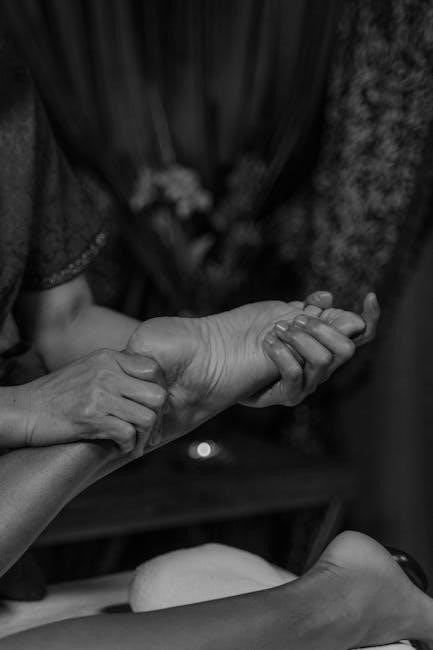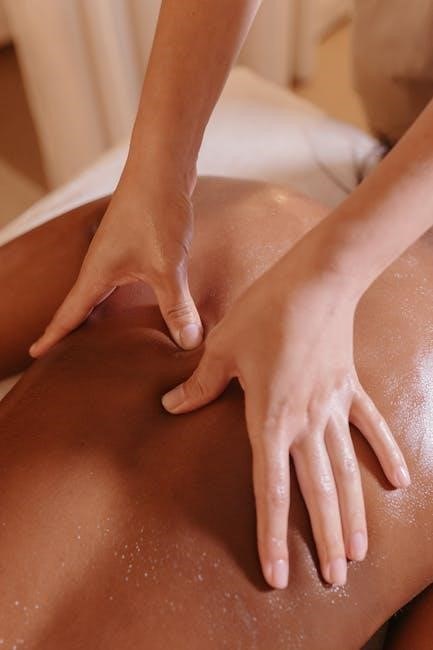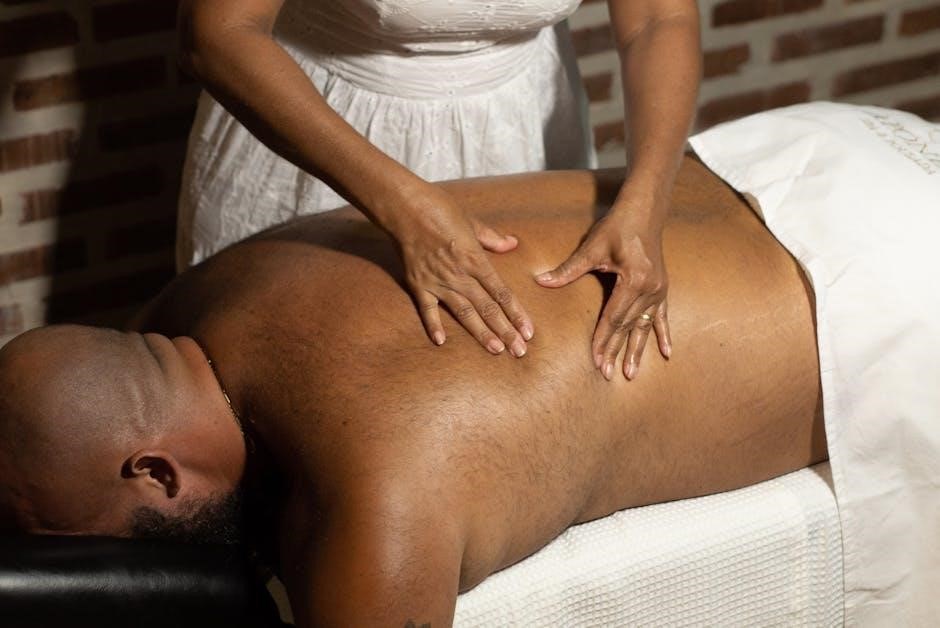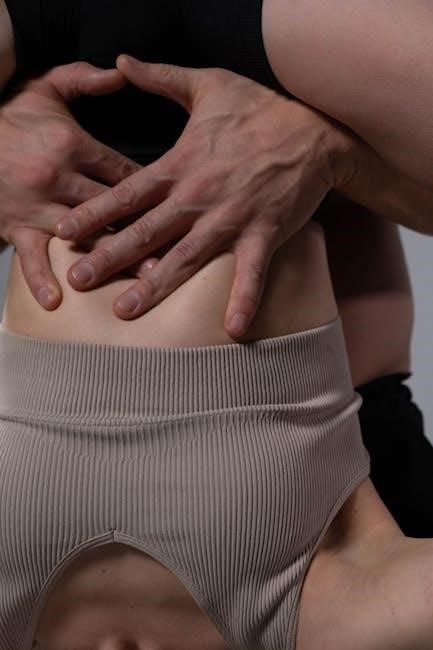Overview of Spondylolisthesis and Its Implications for Physical Therapy
Spondylolisthesis involves a vertebra slipping forward, often affecting L4-L5 or L5-S1. Physical therapy plays a crucial role in managing symptoms, improving stability, and restoring functional movement patterns.
1.1. Definition and Classification of Spondylolisthesis
Spondylolisthesis is a condition where a vertebra slips forward relative to the one below it, most commonly affecting the lumbar spine (L4-L5 or L5-S1). It is classified using the Meyerding grading system, which grades the slippage as I (less than 25%), II (25-50%), III (50-75%), or IV (greater than 75%). Additionally, spondylolisthesis is categorized into types, including degenerative, isthmic (due to a pars defect), congenital, and traumatic. Each type has distinct causes and implications for physical therapy. Accurate classification is essential for developing targeted treatment protocols and ensuring effective rehabilitation outcomes.
1.2. Common Causes and Risk Factors
Spondylolisthesis often arises from repetitive stress or trauma, particularly in young athletes and dancers due to hyperextension. Degenerative changes in older adults, such as facet joint wear, also contribute. Congenital spinal abnormalities and pars fractures (isthmic type) are common causes. Risk factors include weak core muscles, poor posture, and excessive weight. Activities involving repetitive hyperextension, like gymnastics or heavy lifting, increase the likelihood. Genetic predisposition and spinal stenosis further exacerbate the condition. Early identification of these factors is critical for tailoring physical therapy protocols to address underlying causes and prevent progression. Proper assessment helps guide interventions to improve stability and reduce symptoms effectively.

Diagnostic Criteria and Initial Assessment
Diagnosis involves clinical evaluation and imaging. Symptoms include lower back pain, limited mobility, and radiating discomfort. X-rays, MRIs, and CT scans confirm the diagnosis, while physical assessments focus on posture, range of motion, and strength.
2.1. Clinical Signs and Symptoms
Common signs of spondylolisthesis include lower back pain, stiffness, and limited mobility. Patients may experience radiating discomfort or numbness in the legs due to nerve compression. Postural changes, such as an increased lordosis or altered gait, can also be observed. In athletes or individuals with high physical activity, symptoms often worsen with extension movements like bending backward or lifting heavy objects. Early diagnosis is crucial for effective management. Physical therapists assess pain patterns, strength deficits, and functional limitations to guide treatment. Accurate clinical evaluation is essential to develop a tailored rehabilitation plan.
2;2. Imaging and Diagnostic Tools
The diagnosis of spondylolisthesis relies heavily on imaging studies to confirm the extent of vertebral slippage and rule out other conditions. X-rays are often the first step, providing a clear view of spinal alignment and bone structure. Magnetic Resonance Imaging (MRI) is preferred for assessing soft tissues, nerve compression, and disc integrity. Computed Tomography (CT) scans offer detailed bone images, while a SPECT bone scan can detect stress fractures. The Meyerding grading system is used to classify the severity of the slip. Physical therapy assessments, including strength testing and range of motion evaluations, complement imaging to guide rehabilitation planning. These tools collectively inform treatment strategies.

The Role of Physical Therapy in Spondylolisthesis Management
Physical therapy is central to managing spondylolisthesis, focusing on reducing pain, enhancing stability, and restoring functional movement. It employs targeted exercises and interventions to address musculoskeletal imbalances.
Conservative treatments for spondylolisthesis often include physical therapy, rest, and activity modification. Physical therapy focuses on strengthening core muscles, improving flexibility, and enhancing spinal stability. Anti-extension and anti-rotation exercises are commonly recommended to prevent further slippage and alleviate pain. Additionally, patients may benefit from closed-chain gluteal strengthening, which helps stabilize the pelvis and lower back. In some cases, a lumbar brace may be prescribed to provide temporary support and reduce discomfort. Medications, such as non-steroidal anti-inflammatory drugs (NSAIDs), can also be used to manage pain and inflammation. These approaches aim to restore function and prevent progression without surgical intervention. The primary goals of physical therapy in managing spondylolisthesis are to reduce pain, improve spinal stability, and restore functional movement patterns. Therapy aims to enhance core strength, flexibility, and proprioception to support the spine and prevent further slippage. Another key objective is to address muscle imbalances and improve posture. Patients are also educated on proper body mechanics to reduce strain on the affected area. Additionally, physical therapy focuses on promoting functional activities and enabling a safe return to sports or daily activities. The ultimate goal is to maximize the patient’s independence and quality of life while minimizing the risk of progression or recurrence. Key exercises for spondylolisthesis focus on improving spinal stability, strength, and flexibility. These include anti-extension and anti-rotation exercises, core strengthening, and closed-chain gluteal strengthening to enhance spinal support. Anti-extension and anti-rotation exercises are essential for stabilizing the spine in spondylolisthesis. These exercises target the core muscles to prevent excessive spinal movement. Plank variations, side planks, and bird dog exercises are commonly used to strengthen the transverse abdominis and obliques. Anti-rotation exercises, such as Pallof presses, improve rotational control and reduce shear forces on the spine. These interventions help maintain neutral spine positioning, reducing pain and preventing further vertebral slippage. Progression involves increasing resistance or duration, ensuring the exercises remain challenging yet safe. Consistency in performing these exercises is critical for long-term spinal stability and functional recovery. Core strengthening is vital for spondylolisthesis management, focusing on enhancing spinal stability and reducing pain. Abdominal bracing and draw-in maneuvers activate deep core muscles, improving lumbar control. Bridging exercises and superman variations strengthen the extensors, while pelvic tilts enhance flexibility. Dynamic stability exercises, such as single-leg stands and unstable surface training, challenge balance and proprioception. These exercises are performed with neutral spine alignment to avoid exacerbation. Progression includes adding resistance or complexity, ensuring the core remains engaged. Consistent practice of these exercises helps achieve long-term spinal stability and reduces the risk of further injury or slippage. Proper form and controlled movements are emphasized to maximize effectiveness and safety. Closed-chain exercises target the gluteal muscles without putting excessive stress on the spine, making them ideal for spondylolisthesis. Side-step band walks and goblet squats enhance hip and pelvic stability while minimizing spinal movement. These exercises strengthen the gluteus medius and maximus, which are essential for proper gait and posture. Single-limb exercises, such as single-leg deadlifts, improve balance and reduce pelvic tilt. Closed-chain movements are low-impact and avoid spinal extension, making them safe for patients with vertebral slippage. Progression involves increasing resistance or complexity while maintaining proper form. Strengthening the glutes helps stabilize the lower back, reducing pain and improving functional mobility. Consistency is key for long-term benefits. The progression and duration of physical therapy for spondylolisthesis are tailored to the patient’s recovery pace, typically lasting several months. Goals include pain reduction, strength improvement, and functional restoration. Progression criteria focus on symptom resolution and enhanced mobility, with exercises gradually increasing in intensity. The duration varies, but most patients experience significant improvement within 3-6 months. Consistent adherence to the protocol ensures optimal outcomes and safe return to activities. Regular reassessments guide adjustments to the treatment plan, ensuring individualized care and minimizing recurrence of symptoms. Patient education reinforces long-term management strategies. Progression of exercises in spondylolisthesis rehabilitation is based on pain reduction, improved strength, and enhanced functional movement. Patients must demonstrate consistent pain-free or minimal pain during activities. Strength and stability improvements, such as better core activation and gluteal engagement, are key indicators. Additionally, proper form and technique during exercises must be maintained to avoid exacerbation. Functional movements, like bending or lifting, should be performed without discomfort. Progression criteria also include improved range of motion and reduced compensatory patterns. These benchmarks ensure safe advancement and prevent recurrence of symptoms, tailoring the rehabilitation process to individual recovery stages. Regular reassessment guides the progression, ensuring optimal outcomes. The expected duration of rehabilitation for spondylolisthesis varies depending on severity, patient compliance, and individual recovery rates. Generally, the process lasts 3 to 6 months, with the first 4-6 weeks focused on acute symptom management. This phase emphasizes pain reduction, inflammation control, and basic stability exercises; The subacute phase (weeks 6-12) introduces strengthening and flexibility work. Advanced rehabilitation (weeks 12-24) focuses on functional integration and return to activity. Patients with spinal stenosis or higher-grade slips may require longer timelines. Consistent adherence to the protocol and gradual progression are critical for achieving optimal outcomes and preventing recurrence. Regular follow-ups ensure tailored adjustments. A well-structured home exercise program empowers patients to manage symptoms and improve function. Education on proper techniques, posture, and activity modification is essential for long-term recovery and prevention of recurrence. Compliance with a home exercise program is crucial for effective management of spondylolisthesis. Consistency ensures gradual strength improvement and stability. Patients must adhere to prescribed routines to avoid setbacks. Regular performance helps maintain proper spinal alignment and reduces pain. Skipping exercises may lead to relapse or prolonged recovery. Education on the rationale behind each exercise fosters commitment. Monitoring progress and providing feedback enhances adherence. Incorporating exercises into daily routines makes them more sustainable. Consistency and compliance are key to achieving long-term functional improvements and preventing further complications. A home exercise program for spondylolisthesis should focus on core strengthening, flexibility, and proper spinal mechanics. Sample exercises include pelvic tilts to improve lumbar mobility, bird-dog for stability, and planks to enhance core strength. Bridging exercises strengthen the glutes and hamstrings while minimizing strain on the lower back. Gentle cat-cow stretches can improve spinal flexibility. Side-step band walks and goblet squats target hip and gluteal muscles. These exercises, performed 2-3 times daily, help maintain spinal stability and reduce symptoms. Consistency is key to achieving long-term benefits and preventing recurrence of pain or instability. Proper form should always be prioritized to avoid exacerbating the condition.3.1. Conservative Treatment Options
3.2. Goals of Physical Therapy
Key Exercises and Therapeutic Interventions
4.1. Anti-Extension and Anti-Rotation Exercises
4.2. Core Strengthening and Stability Exercises
4.3. Closed-Chain Gluteal Strengthening

Progression and Duration of Physical Therapy Protocol
5.1. Criteria for Progressing Exercises
5.2. Expected Duration of Rehabilitation

Home Exercise Program and Patient Education
6.1. Importance of Compliance and Consistency
6.2. Sample Exercises for Home Use


